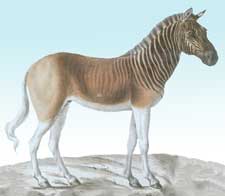
Dimdima
Online Children's Magazine from India

Dimdima
Online Children's Magazine from India
By Rani Iyer

Mammals with odd number of toes or hoofs are grouped under Perissodactyla. These animals walk on the terminal bones of the toes and have enlarged toenails forming hoofs. Perissodactyls either walk on three toes (examples: rhinos, tapirs, many extinct horses) or on a single toe (example: modern horses).
Only seventeen species of perissodactyls remain on the Earth today. Ancestors of the modern horses are known to be present from the Eocene (54 to 33 Million Years Ago). At one time the group was diverse, including the enormous horned Brontotheres, the bizarre browsing, clawed Chalicotheres, and the largest land mammal of all time the Indricotherium, which stands five meters tall at the shoulder.
By Pleistocene (1 Million Years Ago to 11,000 Years Ago), most of the hoofed mammals were extinct. Very few lineages remain alive today. They are horses and zebras (8 species), rhinos (5 species), and tapirs (4 species). However most of the species known today are also endangered. All living rhinos are in danger of extinction, others like quagga (related to zebra) are extinct.
Where have the horses gone? The question puzzled the scientists for many centuries. Only recently, have startling answers emerged for the question. Climate change, over hunting, and disease could be the primary reasons for their extinction.
On the bed of dry bed St. Mary's reservoir in Alberta, scientists have discovered a rich archeological field. Footprints of wooly mammoth, an extinct North- American camel, and skeletons of horse, Equus conversidens, were found in the site. Close by, they also found spearheads. By testing for the protein residue, scientists confirmed that the weapon was used to hunt horses. Thus, about 10,000 years ago man over-hunted several species leading to their extinction. There were no horses in North America until the Spanish invaders re-introduced them in 16th century.
This example illustrates that extinction is possible in any era, even modern times. Unless we are vigilant and understand more about the species we will be helpless to prevent it.
Last updated on :9/23/2003
EXPLORE MORE...
COMMENT ON THIS ARTICLE
Wants to share something related to this article? Please use the form below.
Dimdima is the Sanskrit word for ‘drumbeat’. In olden days, victory in battle was heralded by the beat of drums or any important news to be conveyed to the people used to be accompanied with drumbeats.
Bharatiya Vidya Bhavan
K. M Munshi Marg,
Chowpatty, Mumbai - 400 007
email : editor@dimdima.com
Bharatiya Vidya Bhavan
505, Sane Guruji Marg,
Tardeo, Mumbai - 400 034
email : promo@dimdima.com
Dimdima.com, the Children's Website of Bharatiya Vidya Bhavan launched in 2000 and came out with a Printed version of Dimdima Magazine in 2004. At present the Printed Version have more than 35,000 subscribers from India and Abroad.